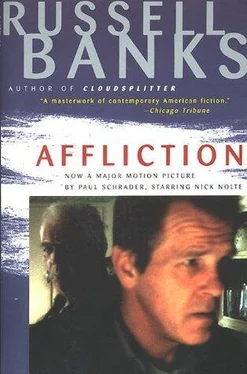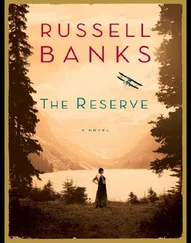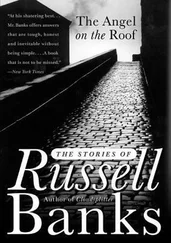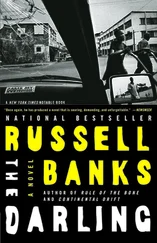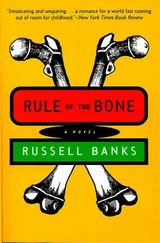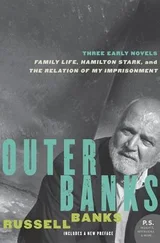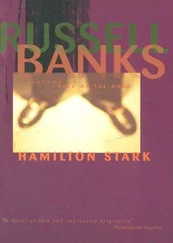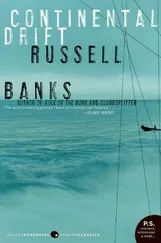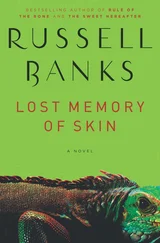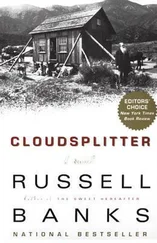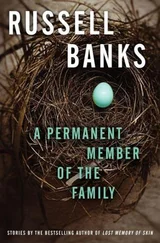He examined his rifle, wiped the snow off it and sighted down the barrel into the gully, lifted it and aimed it toward the town for a few seconds. Then he smiled — an almost beatific smile, golden and warm and filled with understanding, as if a beam of celestial wisdom had entered his brain. He lowered the rifle, slipped the stock under his arm and walked down along the road a few yards to a grove of low pines, where he stepped out of the wind, leaned the gun against a tree, buttoned his jacket and pulled the collar up and put his hands into his pockets, as if for the first time he had felt the cold.
On his left, a precipice dropped off to piles of brush and tangled knots of roots and old dead trees cast there by the mud slide; in front of him the overgrown road descended smoothly to a birch grove in the distance; there it switched back a third time, running toward Wade again, but way below him, below the cliff and the gully and brush, and nonetheless visible to him: so that a man walking uphill, laboring in the cold wind and snow and the vague late afternoon light, especially a man wearing scarlet or bright-orange hunting clothes, would be visible for a long time before he was able to see the other man, who stood waiting for him among the pine trees.
Wade drew his cigarettes from his shirt pocket, looked at the pack for a second and, as if reconsidering, slipped it back. He checked the safety on his rifle, brushed a few flecks of snow from the barrel and hefted it in his hands in a measured appraising way, then turned slightly and leaned his left shoulder and hip against the trunk of a pine tree. When Jack came into sight below — a red flash of cloth moving through the breaks between thigh-thick white birches — Wade lifted the rifle and sighted down the barrel at the bend in the road ahead of him, where Jack would have to turn and face him.
Jack had shot his deer, a huge buck, and he was dragging it out of the woods. He had tied the large gutted body of the animal onto a travois made from a pair of saplings lashed together and extending in a V over and beyond his shoulders. He hauled the deer slowly uphill, leaning forward in the blowing snow and sweating from the effort. His rifle — Evan Twombley’s Winchester — was slung across his chest, and as he trudged up the snow-covered lumber trail the gun slapped rhythmically against him, and he stared steadily down at the slippery rough ground in front of him, as if lost in thought. Behind him, the travois bumped along, causing the deer’s carcass to lurch back and forth; its head, overweighted by the large rack of horns, lolled back against the ground, bloody mouth agape, black tongue extruded, wide-open eyes opaque as onyx, and a thin broken trail of blood dribbled over the trampled snow behind.
When he rounded the bend in the trail, Jack looked up to see how far he still had to go, and he saw the man with the rifle and saw that he was aiming the rifle at the center of his chest; the man was no more than ten yards away and slightly uphill; Jack recognized him at once.
ALL THAT I HAVE DESCRIBED is supported by physical evidence: Wade’s footprints in the snow leading from the road down into the woods, ending thirty feet from where Jack’s body was found, then returning straightway to the road again; Pop’s truck parked there by the road and Jack’s truck gone but turning up three days later in a shopping mall parking lot in Toronto; and, of course, the utter disappearance of Wade himself. His very absence is evidence.
Was he headed for Alaska, where his friend the plumber Bob Grant had gone, run out of money for gas and food in Toronto, abandoned the truck and merged with the migrant population of the city? We do not know; we speculate in solitude; we do not speak of his disappearance to one another.
Maybe we want to believe that Wade died, died that same November, froze to death in his thin sport coat under newspapers on a bench in Harbour Front Park — unknown, unclaimed. But he could just as well have hitched a ride on a train or a truck headed west: Toronto is where the Canadian West begins, where it is very easy to become a nameless wanderer. Maybe tonight, years later, he huddles under a Trans-Canada Highway overpass in a suburb of Winnipeg.
Of course, he could have turned himself into another person altogether, a potter living under an assumed name in a commune in Vancouver. Or, more likely, somewhere along the line he drifted south at a rural border crossing into Minnesota or North Dakota and found a job pumping gas at an all-night truck stop, one of those men with long hair going gray, face masked by a full beard, gaze deflected whenever someone looks hard at them.
But all that is speculation now. We do know that he shot Jack Hewitt — as surely as we know that Jack Hewitt did not shoot Evan Twombley. And we also know that Wade killed his own father— our father. My father. That snowy afternoon, after the fire in the barn was put out, a child-sized pile of char was discovered in the blackened rubble, and a forensic specialist from Hanover easily identified it as the remains of a Caucasian male, aged 65–70, five feet nine, 135–145 pounds. Who else but my father?
It had been assumed at first that the old man’s death was accidental: he was a drunk and probably set the fire himself, smoking, maybe, while fooling with a kerosene lantern. But then came scientific evidence that my father’s death was caused not by fire but by a skull-crushing blow to the head, which must have been inflicted by the last person seen with the old man — seen, less than an hour before the fire started, by Margie Fogg, Wade’s fiancée (for she was still that), and by his daughter, who was also the victim’s granddaughter. And again, there was the incriminating fact that the last person seen with the old man had fled. The evidence, all of it, was incontrovertible. What was not scientific was logical; and what was not logical was scientific.
Just as the evidence that Jack Hewitt did not shoot Evan Twombley, not even by accident, is now seen by everyone as incontrovertible. Even by me. There was no motive, and Jack left no secret bank account, no stash of hundred-dollar bills: the links between Jack and Twombley, LaRiviere and Mel Gordon, existed only in Wade’s wild imaginings — and briefly, I admit, in mine as well.
LaRiviere and Mel Gordon were indeed in business, buying up as much high-country real estate as they could, but there was nothing illegal about it, although it probably was not proper for Mel Gordon to finance the operation with union funds when he was a director and major shareholder in the company receiving the funds. It was a legitimate investment, however, one that has paid off handsomely — for the union membership, for Mel Gordon and Gordon LaRiviere, and for almost everyone else in town too. The Northcountry Development Corporation has brought enormous changes to the region: Parker Mountain Ski Resort is advertised all over the northeast, full-page ads in the Sunday travel section of the New York Times , the Boston Globe , the Washington Post , and so on. Fifteen lifts, seventeen miles of trails from beginners’ to advanced, with several fancy lodges, over a hundred chaletlike condominiums installed along the old Parker Mountain Road in a development called Saddleback Ridge, a half-dozen après-ski lounges, restaurants and bars, including Toby’s Inn, now called the Skimeister’s Hearthside Lodge. The White-house place out on Parker Mountain Road is still in Wade’s name, along with mine and Lena’s, and I keep paying the taxes on it, which keeps it out of LaRiviere’s hands. The house remains empty and looks the way the barn did before the fire. Now and then I drive out and sit in my car and look at the wreck of a house and wonder why not let it go, why not let LaRiviere buy it and tear down the house and build the condominiums he wants there?
Читать дальше
